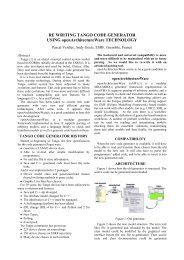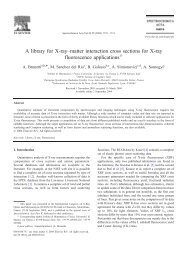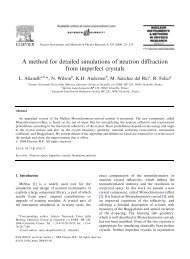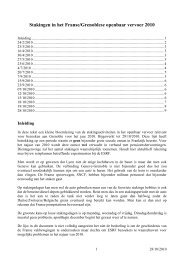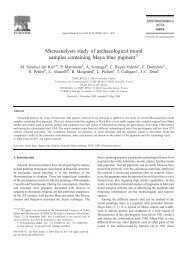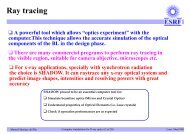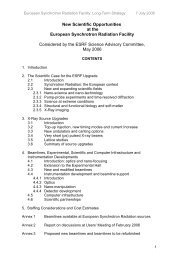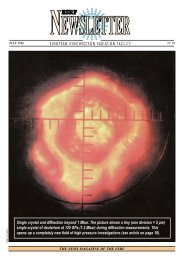Report on future detector requirements at ESRF
Report on future detector requirements at ESRF
Report on future detector requirements at ESRF
Create successful ePaper yourself
Turn your PDF publications into a flip-book with our unique Google optimized e-Paper software.
Powder diffracti<strong>on</strong> in pulsed magnetic fields<br />
Project (Former BL) Applic<strong>at</strong>i<strong>on</strong><br />
PMF (ID06) Powder diffracti<strong>on</strong><br />
Aim of the detecti<strong>on</strong> system<br />
The aim of the detecti<strong>on</strong> system is to collect phot<strong>on</strong>s in order to record a diffracti<strong>on</strong> p<strong>at</strong>tern <strong>on</strong><br />
powder samples. It is the third priority of the beamline, after single crystal diffracti<strong>on</strong> and<br />
high energy diffracti<strong>on</strong>. It can also be used by the MagSc<strong>at</strong> beamline.<br />
M<strong>on</strong>ochrom<strong>at</strong>ic<br />
beam<br />
High field<br />
magnet<br />
Sample<br />
Oper<strong>at</strong>ing c<strong>on</strong>diti<strong>on</strong>s and specific<strong>at</strong>i<strong>on</strong>s<br />
Energy range:<br />
The energy ranges from 15 to 30 keV.<br />
Integr<strong>at</strong>i<strong>on</strong> time:<br />
The magnetic field pulse lasts around 30 ms and is repe<strong>at</strong>ed each 1 to 5 minutes. The<br />
integr<strong>at</strong>i<strong>on</strong> time should be 1 ms during the pulse, with few minutes of pause to save the<br />
d<strong>at</strong>a.<br />
Energy resoluti<strong>on</strong>:<br />
Energy resoluti<strong>on</strong> is not needed.<br />
Detector<br />
Sp<strong>at</strong>ial resoluti<strong>on</strong>:<br />
Sp<strong>at</strong>ial resoluti<strong>on</strong> depends <strong>on</strong> the size of the active area and of the distance to sample. In order<br />
to probe powder and not few single crystals, the beam size is larger than 200 µm. In th<strong>at</strong><br />
c<strong>on</strong>figur<strong>at</strong>i<strong>on</strong>, <strong>on</strong>e can obtain good sp<strong>at</strong>ial resoluti<strong>on</strong> <strong>on</strong>ly by setting the <strong>detector</strong> far from the<br />
sample: <strong>at</strong> least <strong>at</strong> 2 m in th<strong>at</strong> case. C<strong>on</strong>sequently, the <strong>detector</strong> should have an active area of<br />
350x350 mm 2 to 500x500 mm 2 with pixels not larger than 100 to 300 µm.<br />
Dynamic range:<br />
A dynamic range similar or better than th<strong>at</strong> of the current <strong>detector</strong> is required: 16 bits or<br />
better.<br />
Flux <strong>on</strong> <strong>detector</strong>:<br />
The expected flux <strong>on</strong> <strong>detector</strong> ranges between 10 2 and 10 6 phot<strong>on</strong>s/s/pixel.<br />
50



